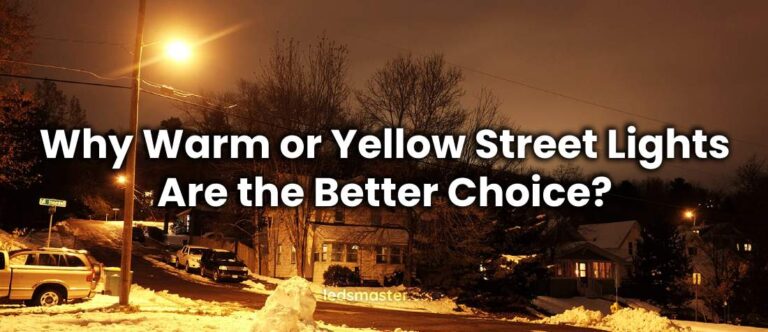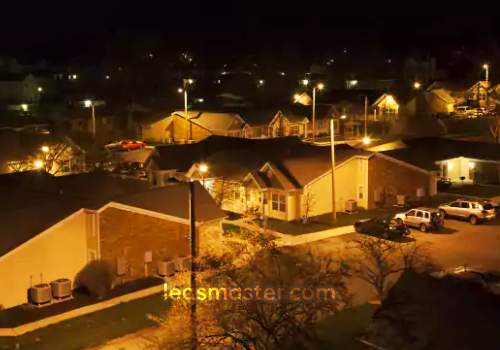
The choice between cool white and warm white lights affects not only visibility but also the overall mood of a space. Discover how selecting the right color temperature can enhance clarity, create inviting settings, and balance environmental concerns to achieve the perfect illumination for any area.
Get your complimentary lighting design today
One important aspect of street lighting is color temperature, which significantly impacts how an area is perceived and how effectively it is illuminated. This article explores the concept of color temperature in street lighting, common color temperatures used, and considerations for choosing between white and warm white lights.
Table of Contents
ToggleColor temperature is a measure of the color of light emitted by a light source, expressed in Kelvin (K). It describes the warmth or coolness of the light and influences how colors appear under the light source. In the context of street lighting, color temperature affects visibility, safety, and aesthetics. It is essential to understand the different color temperatures to make informed decisions about street lighting design.
Street lighting is available in a range of color temperatures, each designed to serve specific purposes and environments. Understanding these different color temperatures helps in selecting the most appropriate lighting for various applications. The most common color temperatures for street lighting are 3000K, 4000K, and 5000K, each offering unique benefits and visual effects.

The 3000K color temperature emits a soft, warm light that resembles the light produced by traditional incandescent bulbs. This warm white light creates a cozy and inviting atmosphere, making it an excellent choice for residential areas and parks. Its gentle illumination helps in reducing the harshness often associated with brighter lighting options, providing a more comfortable and visually pleasing environment. The 3000K temperature is ideal for settings where a relaxed ambiance is desired, and where the lighting should blend seamlessly with the surroundings to enhance aesthetic appeal.
Neutral white light, with a color temperature of 4000K, strikes a balance between warm and cool tones. This color temperature is valued for its versatility, as it delivers clarity and brightness without the starkness of cooler light options. It is commonly used in urban and commercial areas, where a neutral and balanced light is needed to illuminate streets and public spaces effectively. Neutral white lighting provides a clear view without being overly harsh, making it suitable for various settings, from busy city streets to shopping areas and business districts.
The 5000K color temperature produces a bright, crisp light with a bluish hue, which is often referred to as cool white light. This color temperature is particularly effective in areas requiring high visibility and enhanced clarity. It is frequently used for lighting highways, industrial zones, and security-sensitive locations, where visibility is paramount. The cool white light helps in reducing shadows and increasing contrast, thereby improving safety and visibility during nighttime. Its bright and clear illumination makes it suitable for environments where detail and clarity are crucial for both functionality and security.
When selecting street lighting, the decision between white (cool white) and warm white lights involves several considerations. These factors include the intended use of the area, aesthetic preferences, and practical needs. Understanding the distinct characteristics of each color temperature helps in making an informed choice that meets both functional and aesthetic requirements.
Cool white street lights, typically around 5000K, are particularly effective in scenarios where high visibility and safety are of utmost importance. The bright, crisp light produced by cool white fixtures enhances contrast and clarity, which is crucial for various applications.
 On highways and main roads, cool white lighting is invaluable for reducing glare and improving road safety. The bright illumination helps drivers clearly see road markings, signs, and potential hazards, which is essential for preventing accidents and ensuring smooth traffic flow. The enhanced visibility provided by cool white lights contributes significantly to road safety during nighttime driving.
On highways and main roads, cool white lighting is invaluable for reducing glare and improving road safety. The bright illumination helps drivers clearly see road markings, signs, and potential hazards, which is essential for preventing accidents and ensuring smooth traffic flow. The enhanced visibility provided by cool white lights contributes significantly to road safety during nighttime driving.
In industrial and commercial zones, where detailed tasks and security are critical, cool white lights offer a high level of illumination. The bright and clear light enhances visibility, making it easier to perform detailed work and monitor activities. Additionally, the increased brightness helps to deter crime by minimizing shadows and dark spots, thereby improving security in these areas.
Cool white lighting is also advantageous for security and surveillance purposes. The bright, crisp light reduces shadows and enhances visibility, making it easier to monitor and identify suspicious activities. The high level of clarity provided by cool white lights can be a deterrent to criminal behavior and contributes to a safer environment.
Warm white street lights, with a color temperature of around 3000K, emit a softer and more inviting light. This color temperature is often chosen for its aesthetic appeal and the comforting atmosphere it creates, making it suitable for different settings.
 In residential neighborhoods, warm white lighting helps create a pleasant and welcoming environment. The softer light reduces the harshness of brighter options, making streets more visually appealing and less intrusive. Warm white lights enhance the overall ambiance of residential areas, contributing to a more relaxed and friendly atmosphere for residents.
In residential neighborhoods, warm white lighting helps create a pleasant and welcoming environment. The softer light reduces the harshness of brighter options, making streets more visually appealing and less intrusive. Warm white lights enhance the overall ambiance of residential areas, contributing to a more relaxed and friendly atmosphere for residents.
Warm white lights are also ideal for parks and recreational spaces. The gentle illumination provided by warm white fixtures contributes to a serene and inviting atmosphere, enhancing the enjoyment of these areas. The softer light creates a comfortable setting for recreational activities, making parks and public spaces more pleasant for visitors.
For areas with historic or architectural significance, warm white lighting complements traditional aesthetics and helps preserve the character of the surroundings. The soft glow of warm white lights blends harmoniously with historic buildings and streetscapes, enhancing the visual appeal without overwhelming the original design. This makes warm white lighting an excellent choice for maintaining the charm and integrity of historic districts.
Selecting the right color temperature for street lighting involves a careful evaluation of various factors to ensure the chosen lighting solution effectively meets both practical needs and aesthetic preferences. Key considerations include the purpose and functionality of the lighting, aesthetic impact, and environmental effects. Each factor plays a crucial role in determining the most suitable color temperature for specific applications.
The primary objective of street lighting is to enhance visibility and ensure safety for both drivers and pedestrians. The color temperature of street lights can significantly influence how well an area is illuminated and how effectively it serves its intended purpose.
In locations where high visibility is essential, such as busy roads, highways, and industrial zones, cooler color temperatures around 5000K are generally preferred. Cool white lighting offers a bright, crisp illumination that enhances contrast and clarity, which is crucial for ensuring safety and preventing accidents. The increased brightness and reduced glare associated with cool white lights make it easier for drivers to see road markings, signs, and potential hazards, thereby improving overall traffic safety.
Conversely, in areas where creating a comfortable and inviting atmosphere is more important than maximizing visibility, such as residential neighborhoods, parks, and recreational areas, warmer color temperatures around 3000K are often more suitable. Warm white lighting produces a softer, more diffused glow that contributes to a relaxed and pleasant environment. This type of lighting reduces the harshness of brighter options and enhances the visual appeal of the area, making it more conducive to relaxation and leisure activities.
The choice of color temperature can profoundly affect the ambiance and aesthetic quality of a space. The visual impact of lighting not only influences how an area is perceived but also how it fits within its architectural and environmental context.
Cool white lights, with their higher color temperatures, can create a modern and vibrant atmosphere. The bright, bluish hue of cool white lighting is often associated with contemporary design and urban environments. This type of lighting can enhance the visual appeal of modern architectural features and public spaces, providing a clear and crisp illumination that highlights design elements and creates a dynamic, energetic ambiance.
On the other hand, warm white lights offer a more traditional and cozy feel. The softer, yellowish light produced by warm white fixtures is ideal for settings that aim to evoke a sense of warmth and comfort. In residential areas, historic districts, and other spaces where a more classic and inviting atmosphere is desired, warm white lighting complements architectural styles and enhances the overall ambiance. The gentle glow of warm white lights can create a harmonious and aesthetically pleasing environment, aligning with the character and charm of traditional and historic settings.
The environmental impact of street lighting is an increasingly important consideration, particularly concerning light pollution and its effects on wildlife. The color temperature of street lights can influence both the degree of light pollution and the potential disruption to nocturnal ecosystems.
Cool white lights, with their higher color temperatures, often emit more blue light, which can disrupt the natural behaviors of nocturnal animals. Blue light can interfere with the migration patterns, feeding habits, and mating rituals of various species, particularly insects and birds. This disruption can have cascading effects on local ecosystems and biodiversity. As a result, areas with significant wildlife populations may benefit from lighting solutions that minimize blue light emissions and reduce ecological disturbances.
Warm white lights, with their lower color temperatures, typically produce less blue light and are therefore considered less disruptive to wildlife. By emitting a softer, warmer light, these fixtures help mitigate the impact of light pollution, contributing to a more balanced and ecologically friendly lighting solution. This approach helps preserve the natural night environment and supports the well-being of nocturnal species. Additionally, reducing light pollution can enhance the visibility of stars and celestial objects, contributing to a more pleasant and natural nighttime experience for residents and visitors alike.
By understanding the different color temperatures and their applications, you can make informed decisions that enhance the functionality and ambiance of street lighting. Whether opting for cool white lights for high-visibility areas or warm white lights for a more inviting atmosphere, choosing the right color temperature ensures that your street lighting meets both practical and aesthetic needs.